new posts in all blogs
Viewing: Blog Posts Tagged with: Paris, Most Recent at Top [Help]
Results 26 - 50 of 136
How to use this Page
You are viewing the most recent posts tagged with the words: Paris in the JacketFlap blog reader. What is a tag? Think of a tag as a keyword or category label. Tags can both help you find posts on JacketFlap.com as well as provide an easy way for you to "remember" and classify posts for later recall. Try adding a tag yourself by clicking "Add a tag" below a post's header. Scroll down through the list of Recent Posts in the left column and click on a post title that sounds interesting. You can view all posts from a specific blog by clicking the Blog name in the right column, or you can click a 'More Posts from this Blog' link in any individual post.
.jpeg?picon=3306)
By: Zoe,
on 2/11/2015
Blog:
Playing by the book
(
Login to Add to MyJacketFlap)
JacketFlap tags:
Nonfiction,
Fashion,
London,
Paris,
Activity books,
Colouring In,
Sticker books,
Malika Favre,
Hennie Haworth,
Robert Samuel Hanson,
Add a tag
We’ve a week’s holiday from school coming up and will be travelling around the country visiting family, and this means we’ve several multi-hour journeys ahead of us. Journeys are my favourite time for enjoying stories and our bags always include:
our mp3 player loaded up with a new audiobook and some old favourites, along with a splitter, so both children can listen at the same time should they wish to
a couple of new magazines or comics
an activity book or two for busy fingers
Favourite audiobooks include the How to train your Dragon series, voiced by David “former Dr Who” Tennant, enriched with great music and sound effects, David Walliams reading his own stories (not surprisingly, he does really funny voices), and Tony “Baldrick” Robinson’s Theseus and Odysseus. New for our next journey will be The Silver Brumby by Elyne Mitchell (thanks to @HawthornPressUK for the recommendation).
As we subscribe to several magazines and comics at home, reading choices for the train are made from what is available in the station newsagents so that the kids get to try something they wouldn’t have at home. Often they’ll chose a wildlife, craft or archaeology magazine. Technically these may be marketed for adults, but they are often much more engaging than those aimed at kids as they have more content, fewer adverts and less “plastic crap” on the front (a bonus from my point of view).
When looking for activity books to take on journeys my first port of call is always the online shops of museums and art galleries; generally speaking these are good sources of slightly more unusual or quirky activity books. This holiday I’ll be taking DoodleFlip Dress-Up by Hennie Haworth, Stickyscapes London by Robert Samuel Hanson, and also Stickyscapes Paris by Malika Favre.

DoodleFlip Dress-Up is a mix and match, lift the flap fashion colouring-in book. There’s lot to choose from; maybe your creation will have the legs of a ballerina, the floaty dress of a hippy, the accessories of a pirate and the helmet of an astronaut (all figures are female). Prompts suggest ideas for filling several blank flaps with your own designs.

Whilst advertised as 3+, I think the style of illustration will appeal to much older children (say 8+); the designs are quite detailed and relatively small and also look more sophisticated than many colouring-in illustrations aimed at young children.
The two Stickyscapes books are great fun. They are large concertina style fold out cityscapes of the two cities, and come with lots of reusable stickers. One side of each fold-out shows the “real and present-day” city, whilst the other side depicts an “imaginary and historical” version of the city.

There’s lots to learn and explore in both sticker books. A key to each scene is included so you can identify landmarks around the city, and the stickers (a mixture of present-day, historical and fictional people, forms of transport and items you might find on the cities’ streets) come with explanatory notes, making this much more than “just” a sticker book.

I have just one complaint about these books: The population of these cities is far more diverse than the stickers would have you believe.

In the London book, there are perhaps three non-white people represented (out of a total of 33 modern day inhabitants and visitors), or to put it another way 9% of the sticker book modern day population is probably not white. According to the 2011 census just over 40% of Londoners identified themselves as non-white. Comparable figures are not easily obtainable for the French capital, but I suspect the demographics of this city are not accurately represented by the stickers in the Paris book, which could be seen to suggest a 100% white population.

Of course these books are just a bit of fun, and some will say I’m making too much of the hard numbers. But I’d disagree. Why wouldn’t we want the illustrations of these great cities to reflect their rich, mixed populations more accurately?
Alas we won’t be visiting either London or Paris during our travels, but at least we’ll be able to travel there in our imaginations, suitably decked out in the highest of fashion as designed by my kids! What book or story resources do you pack when you’re going on a long journey?
Disclosure: I received the three activity books from the publisher.
Another exhibition opening this weekend is Playtime Paris where designer Gabriela Larios will be showing her portfolioin the Crea tif. Space. From 31st January - 2nd February Gabriela will be exhibiting some of her latest designs, prints and illustrations for the children’s market, created and hand painted in her home based studio in London. Many of them inspired by Gabriela's love for picture

By: JOANNA MARPLE,
on 1/28/2015
Blog:
Miss Marple's Musings
(
Login to Add to MyJacketFlap)
JacketFlap tags:
Maral sassouni,
CROCODILE SHOES,
NO CROCODILES IN TOWN,
Fance,
Montreuil,
NordSüd Verlag,
Interview,
SCBWI,
picture book,
picture books,
Paris,
Illustrators,
Bologna,
Illustrator interview,
LA,
Jen Rofe,
Add a tag
I connected with Maral on Facebook because I swoon at her artwork and because she is a huge Francophile like me. She is relatively new to children’s books, but her work has been well received: selected in Society of Illustrators (Illustrators … Continue reading →

WIP
I came across a really great web shop recently called Deco-Graphic. This French based website not only stocks some great brands such as Atelier LZC, Mini Labo, Isak, Hipp, Ingela, Mr & Mrs Clynk, Fifi Mandirac, Orla Kiely, and Lotta Jansdotter but it also styles it's product shots really nicely. The owners obviously put a lot of time and effort into their photography and create styling with
I write romantic mysteries for a niche market, my stories deal with art, travel, a bit of mayhem and romance. I might preface that with-I love art and I love to travel-and have been fortunate to be able to do so. The old adage write what you know and love is true.
When I started writing, I knew my novel would be set in Paris. In my youth, I lived there for a year, and have since gone back a few times. It stood to reason that my first romance should be set there.
New architectural structures reflect a modern appeal, but the old is appreciated and treasured. The Louvre now has Pei’s Pyramid at the entrance, a few buildings have been added, but the age old charm, the cobblestones, the meandering streets, the essence and soul are still very much there.
The first time I visited Bath, England, I told myself I must come back, and I did. My second book is set there. My third hotel book, my current WIP is set in magical and mysterious Venice. All three cities are mystical and romantic places. Venice has captured my heart perhaps as no other city-there is a constant pull to go back and see what I have missed.
My heroine is an artist, and through her eyes, I introduce my readers to my favorite artists, allow her to live in exciting places, give her mysteries to solve, and someone to love. The best of all worlds.
For me it is essential to visit the place I write about, get a sense of the culture, the everyday, mundane activities that make up our lives. The magical moment of sitting in a cafe, sipping an espresso, and watching people go by. An image is created that will allow a glimpse of that perfect intimate moment. A sculpture in a garden described so well that the reader can almost reach out and touch a sinew, that is the wonder of the written word.
Rodin has always set my pulse racing, his work is strong, exuberant, poignant to the point of agony, and sometimes even mischievous. I tried to bring that sense of joy and discovery to my hero in A Hotel in Paris, and hopefully to my readers. I find solace in art, for me it’s therapeutic. You don’t have to be an art scholar to enjoy it, it’s everywhere we turn, it surrounds us, all we have to do is take note.
Imagine tea at the Pump Room in Bath, and that first sip of the heavily scented Earl Grey tea, you take a deep whiff to savor the smell of the bergamot oil, take a bite of that a fresh scone still warm, loaded with clotted cream and strawberry preserves-except that I skip the cream and go directly for the jam, lots of jam. Those are all real memories that will enrich a story.
Visit a restaurant that has been in business since the early 1600s, in Bath and watch out as you step down on the crooked stairs and touch the warped wall, coated with gobs of thick paint as you continue your descent that doesn’t seem to end, and then you gingerly sit down in a rickety old chair and hope you won’t be sitting on the ancient brick floor instead.
Stand on top of the Rialto Bridge in Venice, look down at the Grand Canal, and the mesmerizing traffic below, boats gliding on water expertly and avoid contact. Sip an espresso in a cafe and listen to a gondolier serenade you from afar.
From the Rodin Museum in Paris, to the Pump Room in Bath, to the dark and narrow canals in Venice, where the water mysteriously shimmers in the moonlit night. It’s all there. Familiarity with a location makes it easier to write about the experience, it makes it come alive.
Even though I write contemporary romance mysteries, I love history and art, and that is what I write about. It goes back to the beginning, write what you know and love.
Cheers,
Margot Justes
A Hotel in Paris
A Hotel in Bath
Blood Art
Hearts & Daggers
Hot Crimes Cool Chicks
www.mjustes.com
 |
| Cartoon by Sarah Macintyre, saying it better than I can in words |
How can we, as children's writers, respond to the horrific massacre in Paris yesterday? As I watched people gather in Paris and London, holding pens in the air as a protest against those who seek to silence, I asked myself how can I use my pen, my ability to write, my privileged position as an author, to oppose and prevent future atrocities?
These are the inadequate answers that I came up with:
- Oppose extremism in every guise. Stress shared humanity and values. Never glorify violence, warfare or death.
- Give children the idea that conflicts can be addressed and even solved through talking.
- Feed and encourage their sense of humour.
- Support the education of children all over the world. The extremists of ISIS and Boko Harem are waging a war on children, slaughtering them in their schools, because they fear the power of reading, writing, thinking.
- Celebrate cartoonists and writers who poke fun at authority.
- Write about the real Islam, the moderate peace-loving Muslims, who are horrified by acts of violence carried out in their name and against many of their community. Do not allow the extremists to become the face of Islam.
- Champion freedom of speech, even if that freedom leads to offence. This is a difficult one, because there's a natural and correct strong urge to avoid giving offence, and so many words can be exceptionally hurtful. I've just written a book set in Amsterdam, where I lived for many years, and I was often surprised by Dutch bluntness - a by product of a deeply held belief in the freedom of speech, whatever offence that may cause.
The assassination of film-maker Theo Van Gogh in Amsterdam by an Islamic extremist just over ten years ago was very similar to yesterday's attack. Van Gogh, like the Charlie Hebdo magazine, made a point of laughing at everyone,insulting everyone, including Muslims. Getting children to understand the appropriate responses to insults and teasing, to understand the difference between personal attacks and criticism of beliefs and ideas is a difficult conundrum - but completely essential. Ultimately the right to offend is an important freedom, even if it's not a very comfortable one
Je suis Charlie, say the placards in the Place de la Republique and Trafalgar Square; in Berlin, Montreal, New York, all over the world. Je suis Charlie. Nous sommes Charlie. But what are we going to do?
By:
Bianca Schulze,
on 12/10/2014
Blog:
The Children's Book Review
(
Login to Add to MyJacketFlap)
JacketFlap tags:
Young Adult Fiction,
Historical Fiction,
Art,
Romance,
Chapter Books,
France,
Paris,
Orphans,
Suspense,
Books for Girls,
French Revolution,
Teens: Young Adults,
Merit Press Books,
Kathleen Benner Duble,
Add a tag
Madame Tussaud's Apprentice is a fascinating historical drama. The rich background of revolutionary France provides readers with a fascinating look at that terrifying time.
By:
Bianca Schulze,
on 12/9/2014
Blog:
The Children's Book Review
(
Login to Add to MyJacketFlap)
JacketFlap tags:
Kate Messner,
Mysteries,
Travel,
Ages 4-8,
Ages 9-12,
Art,
Mystery,
Chapter Books,
France,
Paris,
Add a tag
Manhunt, by Kate Messner, will appeal to middle grade readers who enjoy solving mysteries and who like learning about other countries as well as famous artists and pieces of art.
There have been many bookshops marking all the pages of my life from childhood onwards. There was Mr Oxley's in Alresford, there was the first ever Hammicks, there were all the bookshops of Hay, there was James Thin in Edinburgh, the Libreria Aqua in Venice - each has a special place in my heart. But the one I love most is in Paris.
Shakespeare and Company sits across from the Seine, on a street slightly aslant from the Quai St Michel, and I loved it the moment I first walked into it in 1981. In those days (and probably still), you could work there for a bed in one of the book-lined upstairs rooms.
I did for a while, and it was a place of companionship, laughter, and above all, a shared love of books. It is, quite literally, a treasure trove, a mish-mash of the new, the secondhand and the simply arcane and archaic. I went back there today with my children, and they were immediately lured in and entranced by the smell of dusty paper, the feeling that the perfect book must be just around the next corner, or just out of reach up that wooden ladder.
For all that it is much more of a tourist destination nowadays, the old magic is still there. It has that indefinable Narnia feel which makes you believe that somewhere in there is a door or doors to another world. There are, of course, because that's what books are - but surely somewhere there's a tiny key, or a bookspine to rub which will take you somewhere else entirely.
Every writer who visits Paris has been there - and it is a great honour to be asked to read in the little upstairs room with the sofas and the book nook with a tiny desk and endless fluttering pieces of paper, covered in scribbled dreams. Some of those writers are even featured on the wallpaper...
There is a wonderful children's and YA section, where I was happy to see many of my lovely author friends featured (though sadly not me), and an invitingly padded alcove just perfect for a child to curl up on and read one of the pile of picture books which leans against the wall.
If you go to Paris, do try to make time to go there - and may you be as transported with delight as I have always been...(and take note of my favourite quote above)!
"If you’re going to select only one revolting, repulsive pirate book, this is arrrr-guably the best." Kirkus

By: Neil Gaiman,
on 10/17/2014
Blog:
Neil Gaiman
(
Login to Add to MyJacketFlap)
JacketFlap tags:
Dave McKean,
paris,
Vienna,
chris Riddell,
Hamburg,
Cologne,
Indies First,
The Sleeper and the Spindle,
The Kiss,
Add a tag
posted by Neil Gaiman
It's autumn in this part of the world, and the trees are amazingly beautiful. A few weeks ago they were red and green, now they're mostly shades of brown, orange and gold, and every now and again a tree decides to simply shed itself of leaves, like someone taking off their overcoat and dropping it on the floor where they stand, and the leaves drop or spin and it's all so gloriously autumnal and pre-Hallowe'eny it feels like there's a set designer arranging it all.
And I'm leaving it all.
I'm headed off to Hamburg on Monday Night
http://www.literaturhaus-hamburg.de/), Cologne on Tuesday, (
http://www.literaturhaus-koeln.de/showtermine.php?id=931). These are sold out. Vienna on Wednesday, at 7:30 pm at
Buchhandlung Morawa in Vienna Wollzeile 11, 1010 Wien (I can't see anywhere online to get tickets, so assume it's a just turn up event).
From there I go to Paris. On Thursday night (its the 23rd), around 7 pm, Dave McKean and I will be at the gallery opening for Dave's beautiful red and black and white SMOKE AND MIRRORS drawings at Galerie Martel, 17 Rue Martel, Paris.
http://www.galeriemartel.com,
https://www.facebook.com/events/282927571907816/On Friday the 24th, at 6pm I'll be doing a SIGNING in Paris. Well, technically in Vincennes, at the Millepages. Librairie 91, rue de Fontenay Vincennes. The
page is here. No tickets or anything needed, just turn up and I will sign your books or comics or arm.
(There was a 3:00 on Saturday signing mistakenly announced for me and Dave McKean at Galerie Martel, but that's ONLY DAVE as I'm off being interviewed then. So if you are in France and you want something signed, come to the Vincennes signing.)
***
The Sleeper and the Spindle, illustrated by Chris Riddell, is coming out this week in the UK. I've been fascinated by the articles that have come out centering around this illustration, of the queen waking the sleeper. It's been applauded for things it is and things it isn't, decried as pornographic, and pretty much everything in between. I think it's beautiful, but then, I think everything about this book is beautiful, from the transparent cover and the gold ink details on. (
Here's a restrained piece from The Guardian, from whose website I stole the above picture.)
(It's only for sale soon in the UK, Australia and New Zealand. If you are anywhere else and want it before the end of the year, you should probably order it. Here's
the Book Depository Link (with Free worldwide delivery), the
Amazon.co.uk link and here is the
UK Local Bookshop link. I should warn you also that the paperback edition you can preorder on Amazon won't be out for a year. But you will want to get the hardback, because it is an object of pure beauty.)
...
Are you an author? Are you someone who owns an independent bookshop who knows authors? Amanda and I wrote a letter to authors and bookshops, about the Saturday after US Thanksgiving.
Last year, Sherman Alexie came up with an idea so audacious and imaginative it could only have been conceived by an author who wanted to be allowed behind the counter in a bookshop. The idea, “Indies First,” is this: authors get to spend a day hand-selling books and helping out in their local independent bookshop.
Good, right? You, an author, will experience the joys and frustrations of being a bookseller. Mostly the joys — it’s one of the busiest days of the year for small businesses, especially in bookshops. The day in question is the Saturday after Thanksgiving, “Small Business Saturday.” People are beginning to buy gifts for the holidays (now is your chance to persuade people that they need your books — especially if you’ve signed them — and your friends’ books, and books you’ve always loved that, if widely read would make the world a better place). It will be, we promise you, a much more sociable day than the ones you spend staring at a blank screen or a white sheet of paper, communing with imaginary people and suchlike.
(You can read the whole letter at the link. We plan to work at three different local bookshops that day.We have a plan.)





Cat lovers will enjoy the brand new collection from Audrey Jeanne. Audrey is an illustrator based in Paris who has taken a lot of inspiration for these designs from her Siamese cat Mikado. New items include postcards, prints, badges and notebooks. See these designs and many many more online here.

By:
[email protected],
on 9/16/2014
Blog:
Perpetually Adolescent
(
Login to Add to MyJacketFlap)
JacketFlap tags:
japan,
literary fiction,
Paris,
Text,
haruki murakami,
Book Reviews - Fiction,
Joy Lawn,
Mark Henshaw,
Out of the Line of Fire,
Snow Kimono,
Add a tag
A buzz has been building about Australian author Mark Henshaw’s long awaited second novel after Out of the Line of Fire. The Snow Kimono (Text) is a literary psychological thriller set in Japan and France. Insights into both those countries shape the contours, ridges and atmosphere of the novel. Paris is wet and snowy and […]
By:
Sue Morris,
on 7/25/2014
Blog:
Kid Lit Reviews
(
Login to Add to MyJacketFlap)
JacketFlap tags:
5stars,
Library Donated Books,
Debut Illustrator,
chinldren's book reviews,
Jackie Clark Mancuso,
Paris-Chien: Adventures of an Ex-Pat Dog,
Small Press United,
Children's Books,
Picture Book,
dogs,
Paris,
Debut Author,
Hudson,
making friends,
Add a tag
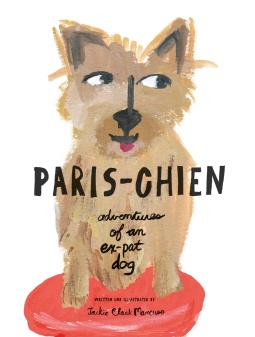 .
.
Paris-Chien: Adventures of an Ex-Pat Dog
written & illustrated by Jackie Clark Mancuso
presenting Hudson
distributed by Small Press United 6/05//2013
978-0-615-54542-4
Age 4 to 8 36 pages
.
“When Hudson, an adventurous Norwich Terrier, moves to Paris, he loves the new sights and smells. But when he tries to make friends, he is surprised to discover that the dogs only speak French. Little Hudson’s desire to make friends and thrive in his new environment is so strong that he learns a new language. Hudson becomes a Parisian, or Paris-Chien, (chien means dog in French).”
Opening
“Hi. My name is Hudson. My mom is a writer and we’ve come to live in Paris for a year.”
Review
Poor Hudson, the real-life dog who owns author/illustrator Mancuso, he now lives in a new culture, with a new language, and one he does not understand or speak. Hudson tries to make friends, but cannot understand anything the French pooches are saying. He wants to go back home. Mom said no, but did have an idea.

I like the beginning of Paris-Chien. Hudson tells us about life as a dog in Paris. People take their beloved pooches everywhere. One guy even takes his dog to work at a shoe store where he greets people. The dog also greets entering customers. How cool is that? Even restaurants accommodate dogs with a human; sometimes with the best table. Hudson also goes to all sorts of places, along with his mom. No matter how he tried, poor Hudson cannot communicate with any other dog.
The story flows nicely from point to point. When Hudson takes lessons in French—Mom’s brilliant idea, taught by a French Poodle (of course)—he begins to pick up the language and other dogs can now understand him. Hudson even found himself a girlfriend! She is a lovely looking French poodle. Did you expect any other breed? The illustrations are nice. Done in gouache, the bright areas are nearly flawless and the lighter areas give the illustrations texture. I love Hudson as he studied—with heavy black glasses perched on his snout.

Children who like dogs will love Paris-Chien, as will adults. Anyone who has experienced the dog culture of Paris will recall memories of time spent there on each page. The animals are adorable, with many breeds represented. There is also a cat, and a squirrel (which is risky given how dogs take off after the rodents). Ex-pat Mancuso’s Parisian dogs are obedient and stay where the illustrator places them in the real Parisian locations. The funny and unexpected twist in the story is good.
Dog parks are finally starting to appear throughout the US, but with Paris dogs having nearly free reign (going to work, and in and out of restaurants. When Hudson cannot find a place to play, and the park he finally finds does not allow dogs—the only one in all of Paris—I loved the twist. Inside the back cover is a list of French words with their English counterpart. Maybe kids who read about Hudson will learn French right long with the smart ex-pat canine. Debut author / illustrator Jackie Clark Mancuso lived in Paris with her dog, Hudson. She based the locations on places she and Hudson frequent. Now that he knows some French, Hudson is a happier dog, willing to somplete their tour of Paris.
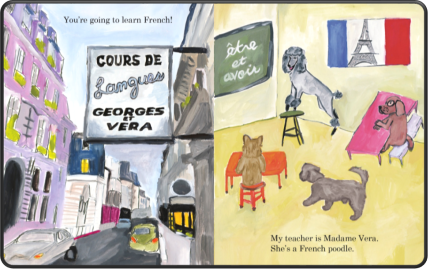
PARIS-CHIEN: ADVENTURES OF AN EX-PAT DOG. Text and illustrations copyright ()C 2012/2013 by Jackie Clark Mancuso. Reproduced by permission of the author, Jackie Clark Mancuso, Los Angeles, CA.
Buy Paris-Chien: Adventures of an Ex-Pat Dog at Amazon —B&N—Book Depository—iTunes—author’s website—at your favorite bookstore.
—B&N—Book Depository—iTunes—author’s website—at your favorite bookstore.
Learn more about Paris-Chien: Adventures of an Ex-Pat Dog HERE.
Meet the author / illustrator, Jackie Clark Mancuso, at her website: http://jackiemancuso.com/
Find more books the Small Press United website: http://www.smallpressunited.com/
French Press.

.
.

Filed under:
5stars,
Children's Books,
Debut Author,
Debut Illustrator,
Library Donated Books,
Picture Book Tagged:
chinldren's book reviews,
dogs,
Hudson,
Jackie Clark Mancuso,
making friends,
Paris,
Paris-Chien: Adventures of an Ex-Pat Dog,
picture book,
Small Press United 








By: Alice,
on 7/22/2014
Blog:
OUPblog
(
Login to Add to MyJacketFlap)
JacketFlap tags:
Books,
Music,
paris,
world war I,
first world war,
debussy,
*Featured,
Arts & Leisure,
music composition,
Claude Debussy,
Eric Frederick Jensen,
Master Musician series,
1147651,
refrain—“revenge,
berceuse,
Add a tag
By Eric Frederick Jensen
When war was declared in the summer of 1914, Claude Debussy was fifty-one. Widely regarded as the greatest living French composer, he lived in Paris in a fashionable, elegant neighborhood near the Bois de Boulogne. Politics had never held much interest for him, and as the movement toward war increased in both France and Germany, Debussy’s focus was on more personal matters. He worried about his growing debt, a result of consistently living beyond his means. And he was frightened by his lack of productivity: in the past few years he’d produced only a handful of compositions.
When France’s armies were mobilized, Debussy was genuinely astonished by the fervor it aroused. He himself was not a flag-waver, and took some pride in observing that he had never “had occasion to handle a gun.” But he was drawn into a more active role as family and friends became involved, and as the German invasion threatened to overrun Paris.
That September he witnessed the repulse of the German forces from temporary asylum in Angers, and grew increasingly horrified by daily reports in the French press of “Hun atrocities” against civilians in Belgium and France. The violation of Belgian neutrality by the Germans (“the rape of Belgium”) served as the basis for what became a well-organized propaganda campaign, one that soon drew on Debussy’s fame.
One of the first publications intended to broaden support for the Allies appeared in November 1914: King Albert’s Book. A Tribute to the Belgian King and People from Representative Men and Women Throughout the World. The popular English novelist, Hall Caine, was listed as “general organizer,” and there were more than 200 contributors from all branches of the arts, including Edward Elgar, Jack London, Edith Wharton, Walter Crane, Maurice Maeterlinck, and Anatole France. Debussy was one of the few composers approached to be part of the project, and contributed a short piano piece, Berceuse héroïque. He described it as as “melancholy and discreet . . . with no pretensions other than to offer a homage to so much patient suffering.”
The Berceuse was followed by two brief piano pieces similar in intent: Page d’album and Elégie. Page d’album was composed in June 1915 for a concert series created to supplying clothing for the wounded. Debussy’s wife, Emma, was involved with the project, and that helps to explain his participation. The Elégie, a simple and solemn piece, was published six months later in Pages inédites sur la femme et la guerre. Profits from sale of the book were intended for war orphans.
That same month Debussy completed his final work directly inspired by the war effort: Noël des enfants qui n’ont plus des maisons (Christmas for Homeless Children). Here Debussy presented children as an illustration of the horror and atrocities of war. He composed both words and music. Its recurrent refrain—“Revenge the children of France!”—gives an indication of its mood. (The following year Debussy started work on a cantata about Joan of Arc, Ode à la France, set in Rheims—whose cathedral, destroyed by German shelling, had become a symbol both of French fortitude and German barbarity—but completed only a few sketches.)
Life in Paris during the war years became more and more of a challenge, with increasing shortages of food and fuel, and a steady escalation in their cost. In time it became difficult for Debussy simply to earn a living. Concert life was reduced, as were commissions for new compositions. Debussy’s last surviving, musical autograph—a short, improvisatory piano piece—was presented as a form of payment to his coal-dealer, probably in February or March 1917.
It came as a surprise to Debussy that, in the midst of all these hardships, he began to compose more than he had in years, including works more substantial in size and broader in their appeal. Among them were En Blanc et Noir (for two pianos), the Etudes (for solo piano), and a set of sonatas, including ones for violin and cello. These were not propagandistic pieces, but the war affected them nonetheless. They were created, Debussy confided to a friend, “not so much for myself, [but ]to offer proof, small as it may be, that 30 million Boches can not destroy French thought . . . I think of the youth of France, senselessly mowed down by those merchants of ‘Kultur’ . . . What I am writing will be a secret homage to them.” For the sonatas, the last compositions completed before his death, he provided a new signature: “Claude Debussy, musicien français”—an indication not just of Debussy’s nationalism during a time of war, but of the heritage he drew upon in writing them.
Debussy died of cancer on 21 March 1918, at a time when Paris was under attack as part of a mammoth, final German offensive. But by that time his perception of the war had altered. The years of carnage had made a straight-forward patriotic stance simplistic. “When will hate be exhausted?” Debussy wrote. “Or is it hate that’s the issue in all this? When will the practice cease of entrusting the destiny of nations to people who see humanity as a way of furthering their careers?”
Eric Frederick Jensen received a doctorate in musicology from the Eastman School of Music. He has written widely in his areas of expertise: German Romanticism, and nineteenth- and early twentieth-century French music. His studies of Debussy and Robert Schumann are in the Master Musicians Series.
Subscribe to the OUPblog via email or RSS.
Subscribe to only music articles on the OUPblog via email or RSS.
The post Debussy and the Great War appeared first on OUPblog.

By:
Guest Posts,
on 6/19/2014
Blog:
The Children's Book Review
(
Login to Add to MyJacketFlap)
JacketFlap tags:
Mysteries,
Ages 9-12,
Mystery,
Chapter Books,
France,
Paris,
featured,
Books for Girls,
Clothes and Fashion,
Carina Axelsson,
Model Undercover series,
Add a tag
When I wrote the first notes about my sixteen-year-old detective, Axelle Anderson, I was living in Paris, France, doing a short stint as PA to fashion designer John Galliano (then designing for the fashion house Christian Dior), so the fashion world was more on my mind than ever, and the idea of a fashion mystery took hold straight away.

By: Elyse Turr,
on 6/10/2014
Blog:
OUPblog
(
Login to Add to MyJacketFlap)
JacketFlap tags:
Books,
History,
Literature,
resistance,
WWII,
France,
paris,
World War II,
Europe,
*Featured,
française,
Occupied France,
David Ball,
Diary of the Dark Years,
Drieu La Rochelle,
Jean Guehenno,
Nazi Occupation,
Second Wrold War,
guéhenno,
0067,
Add a tag
By David Ball
If you were a fifty-year-old intellectual, a well-known writer of left-wing articles and literary essays, and your country was occupied by the Nazis and its more-or-less legal government collaborated with them — and now the editor of the leading literary magazine of the time pressed you to contribute an essay to his review, would you do so? Just an essay on Voltaire for the Nouvelle Revue Française, mind you, nothing subversive. Anything at all suspect would be censored anyway.
The answer, for the overwhelming majority of French intellectuals in 1940-44, was “Write the article, of course!” And keep writing, whatever happened to France. Not about the war, of course, or the Occupation—you couldn’t do that—but novels about personal relationships, plays, literary articles and criticism, why not? André Gide kept on publishing his Journal; Sartre finished Being and Nothingness, wrote No Exit and saw it produced on the Paris stage; Simone de Beauvoir published a novel and a philosophical essay; utterly non-fascist writers like Colette, Jean Anouilh, and Marcel Aymé contributed to actively pro-fascist journals. In short, judging from what they wrote at the time, most French writers seem to have lived through four years of Nazi occupation without noticing it. You would think they had never seen the swastika floating from the Eiffel Tower, nor the huge banner hanging over the front of the Chamber of Deputies which housed the French parliament before the war: DEUTSCHLAND SIEGT AN ALLEN FRONTEN (“Germany is winning on all fronts”), nor the booted German soldiers who paraded down the Champs-Ėlysées every day. And apparently never read about the execution of hostages or Résistants reported in the daily papers or on posters in the Paris Metro, and never heard about friends and acquaintances arrested and deported “to the East.”
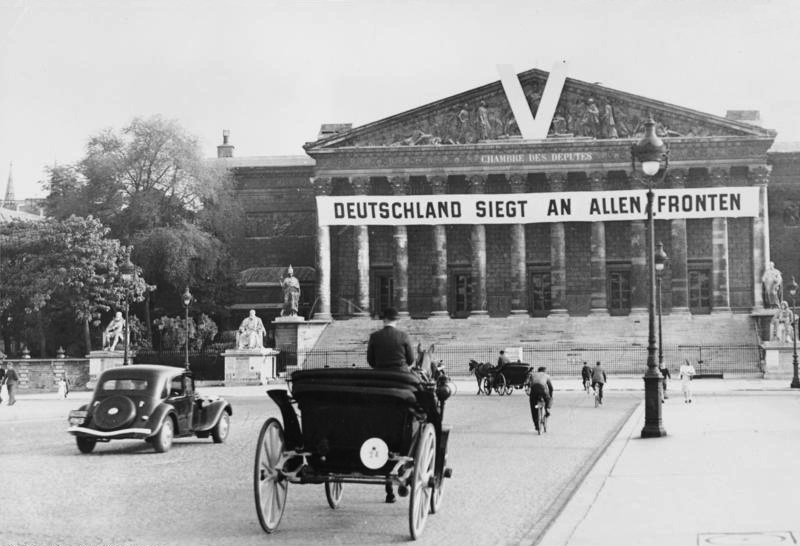
Paris, deutsche Parole am Bourbon-Palast. Bundesarchiv, Bild 183-2004-0216-500 / CC-BY-SA via Wikimedia Commons
Jean Guéhenno, whose portrait I have sketched in the first paragraph, was a notable exception. His answer to Drieu La Rochelle, a literary acquaintance of his and the ardently fascistic writer who edited the Nouvelle Revue Française from 1940 to 1943, was silence — and inner rage, which he noted in his diary: “We have no means of telling these gentlemen what we think of their activity. At least they might leave us in peace.” (24 January 1941)
He had resolved to remain silent, not to write a word for a publishing industry under Nazi control, not to “play our jailors’ game,” as he later put it, “to appear as if we were still living and enjoying ourselves as we used to, in the time when we were free.” He remained silent, but he wrote. He kept his diary, where he noted details of ordinary Paris life under occupation (some extraordinary ones, such as the first round-up of Jews in Paris), his thoughts on French literature (especially the great texts he was teaching), and above all his anger at the stupidity, cowardice, and vanity of those of his fellow countrymen who played along with the Nazis, the politicians (Pétain, Laval and company) and “the species of men of letters, [which is] not one of the greatest species in the human race. The man of letters is unable to live out of public view for any length of time; he would sell his soul to see his name ‘appear.’” (30 November 1940) Guéhenno also worked away at his two-volume biography of Rousseau, “the exemplary life of a man who does not surrender,” he notes (17 July 1940) — the very image of Jean Guéhenno himself. He would publish his diary and the Rousseau biography when the war was over and France was free.
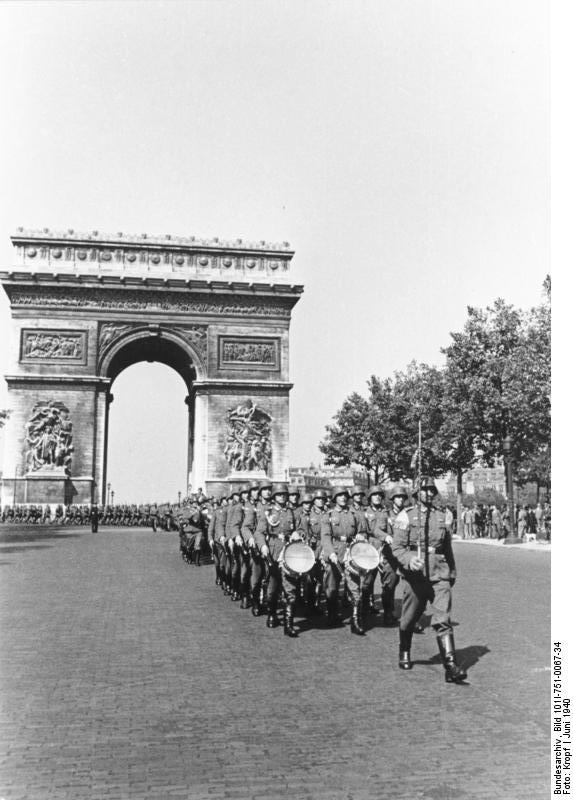
Paris, Parade deutscher Soldaten . Bundesarchiv, Bild 101I-751-0067-34 / Kropf / CC-BY-SA via Wikimedia Commons
Guéhenno was too well known as an anti-fascist intellectual ever to join one of the Resistance networks which soon sprang up in occupied France. It would have meant his arrest and that of his comrades. He was under surveillance, and he knew it. He taught in some of the elite schools of France, but just being who he was and teaching French literature as he always had was enough to get him “demoted” by the Ministry of Education of the Vichy government. In the last year of the Occupation, he did meet with other writers (his friend François Mauriac, for example) and discuss what they could do, as writers, to keep the spirit of freedom alive in France. They distributed underground literature in Paris. In 1944, Ėditions de Minuit, the remarkable underground publishing house which managed to print so much free-spirited French prose and poetry clandestinely during the last three years of Nazi occupation, put out part of Guéhenno’s diary under the title “In the Prison.” He signed it “Cévennes,” the name of the mountain range in central France where Protestants had hid to resist persecution four centuries earlier. (It also echoed “Vercors,” the name of the mountains where the Resistance had concentrated thousands of armed men, and the pseudonym of Jean Bruller, who founded the house; his novella “The Silence of the Sea” was the first work it published.)
It was a pleasure to live with this honorable, stubborn, cultivated and passionate man for a few years, translating, annotating and presenting his Diary of the Dark Years: 1940-1944 so that today’s English-speaking readers could understand this unique piece of testimony to the inner and outer life of a French intellectual under Nazi Occupation.
David Ball is Professor Emeritus of French and Comparative Literature, Smith College. He is the editor and translator of Diary of the Dark Years, 1940-1944: Collaboration, Resistance, and Daily Life in Occupied Paris.
Subscribe to the OUPblog via email or RSS.
Subscribe to only history articles on the OUPblog via email or RSS.
The post Life in occupied Paris during World War II appeared first on OUPblog.

I'm in the space between novels at the moment - in the eye of the creative storm, so to speak. It's a necessary space for me, a place where I give myself the time to do ordinary things, let my mind wander - and feed my creativity by doing something completely different in the writing line. Sometimes I'll work on a picture book, but I'm more likely to write poetry - most of which goes into the big box marked 'never show this to anyone'. Usually I challenge myself to master a new form of verse - I attempted triolets last time - but quite often I'll go back to an old friend. I love the discipline of iambic pentameter, or I might dip into a sonnet, a ballad, or even a limerick.
One of my favourite forms of poetry to write is haiku. To condense so much feeling and atmosphere into so few words is an art--and a difficult one. I have never managed to write one to my own complete satisfaction (and certainly not one I'd be happy to show in public), but I'll always keep trying. It is an art worth working at.
As a student I remember marvelling over Ezra Pound's In a Station of the Metro from "Contemporania," Poetry: A Magazine of Verse, 2.1 (April 1913), which I make no apology for repeating here in case there are those who do not know it:
The apparition of these faces in the crowd:
Petals on a wet, black bough.
With a boyfriend in Paris at that time, I spent a lot of hours riding the Metro and mouthing the station names of Denfert-Rochereau, Chatelet-Les Halles, Pyramides, Arts et Metiers, Sevres-Babylone (a poem in themselves, and so much more romantic than Marylebone, Ealing, Euston or Lewisham). I understood Pound's words exactly from my own experience, and even now they conjure up the frantic, crowded platform jostling, the harsh braying note of the closing doors and the slightly sweet smell of sewers and smoke from a million damp Gauloise cigarette butts which would say 'Paris' to my senses even if I were blindfolded.
Years after Paris, I made a trip to Japan, the true home of haiku. Riding the Tokyo Metro was a different experience entirely, and yet just as evocative in its way. Coming in from Narita airport I remember eating sea-fresh sushi from my first bento box and marvelling at brown-grey jagged hills covered in pine trees and moss, exactly like a Hokusai print--and that was before I'd even seen Mount Fuji.

In Japan I felt tall for the first time--but also alien, standing out like a sore thumb above the massed commuters on the platform, trying to read signs in a language I had no hope of understanding. Somehow, though, I trusted myself to one of the seemingly familiar coloured lines on the map and arrived where I was meant to be--a place where a friend had told me I would find a taste of the 'real' Tokyo, far from the blazing multi-coloured neon signs of Shibuya and the clicking cameras whirring outside the Imperial Palace. In Shinjuku I got lost deliberately--the best way to discover unexpected wonders.
There was the tiny shop with a window full of wooden shoes, which I entered down three rickety steps to find a tiny grey-haired woman bowing to me. I bowed back politely, and suddenly the lack of language was no longer a barrier. With mime and hand gesture and more bowing, we communicated perfectly, and I left with three exquisite pairs of shoes, destined for the (then) small feet of Lovely Daughter, her brother and my god-daughter, all wrapped in patterned paper with a little string to carry them by. I wandered deserted shrines with small offerings of food and flowers before them, and then found myself in a busy market where I was, once again, alien--the alien window shopper amongst a sea of hurrying, haggling housewives buying live chickens, leafy vegetable, roots large and small and rice from great hoppers as tall as the eaves.
There were many more metro trips along the coloured lines of Chiyoda, Marounouchi, Yurakucho, Asakusa and Oedo, but the final one took me to the peaceful woods of the Emperor Meiji's garden--tribute to his beloved Empress wife. Here's what I wrote about it. Not a haiku, but I like to think it has some of the idiophones which characterise other Japanese poetry.
In Emperor Meiji's garden
black bright carp
dance
their slow drumbeat
on waterlily ripples.
The Empress Shoken sleeps
and nesting crows
sound
requiems of flight
above the weeping trees.
copyright © Lucy Coats 1998
For me, it's a word picture which conjures up how I felt in that particular time and place, better than any photograph could. That's why I'll keep on writing poetry in the in-between times - whether I show it to anyone or not.
"A rollicking story and a quite gloriously disgusting book that children (especially boys) will adore!" Parents In Touch magazine
"A splendidly riotous romp…Miss the Captain’s party at your peril." Jill Bennett
"An early candidate for piratey book of the year!" ReadItDaddy blog
"A star of a book." Child-Led Chaos blog
Lucy is represented by Sophie Hicks at Ed Victor Ltd
By:
Sue Morris,
on 5/16/2014
Blog:
Kid Lit Reviews
(
Login to Add to MyJacketFlap)
JacketFlap tags:
4stars,
Micah Player,
Contests-Giveaways,
Library Donated Books,
around-the-world,
Lately Lily,
travelling girl,
Zeborah,
Children's Books,
Picture Book,
Chronicle Books,
London,
Paris,
adventures,
traveling,
friendships,
Add a tag

Welcome to day 6 of Children’s Book Week. These last two days of Children’s Book Week 2014 Kid Lit Reviews presents two publishers well-known for their children’s books, in particular, picture books. Tomorrow Capstone will present two books you could win. Today Chronicle Books is sponsoring Lately Lily: The Adventures of a Travelling Girl. To WIN this picture book LEAVE A COMMENT! For additional entries, CLICK HERE TO WIN!
.
. 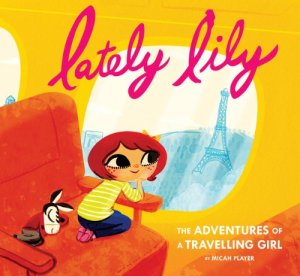 .
.
Lately Lily: The Adventures of a Travelling Girl
by Micah Player
Chronicle Books 3/25/2014
978-2-4521-1525-2
Age 4 to 8 32 pages
.“Meet Lily the Travelling Girl! Where has Lily been lately? EVERYWHERE! Lily takes her trips by plane, train, bike, boat, and even by camel, and her best friend,, Zeborah, is always along for the ride. Whether venturing far away or staying close to home, Lily knows that the joy of discovery is the best way to travel each and every day. Join the jet-setting Lily on a world tour, and experience the surprises of ravel through her eyes.”
Opening
“BONJOUR! CIAO! HOLA! HELLO! I’m Lily, the Travelling Girl.”
The Story
Lily’s parents work all over the world and take Lily with them. Lily takes Zeborah, her stuffed zebra doll and best friend. As the story progresses, you will learn where Lily has been—lately, meet her friends, and discover what she does.
Review
The author/illustrator, Micah Player, is the Creative Director of a company that makes kids apparel. That company, called Lately Lily, “the international teeshirt brand for thoughtful little girls,” specializes in clothes for young girls age 2 to 10, all based on Lily and her travels. Lily’s parents are a journalist and a photographer for the International Exposition (the Definitive Journal of Global Curiosity), working around the world. According to Lily’s website, the International Exposition is the world’s greatest magazine.
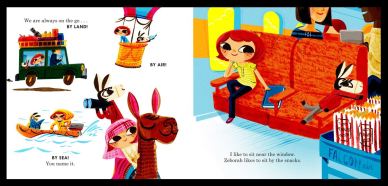
Lily travels carrying her yellow suitcase—her home away from home—and Zeborah, a stuffed zebra-doll. Lily writes notes in her journal describing her travels. These notes are what inspire the fashions at the store. In addition to this book, Lately Lily also has flashcards and a yellow suitcase, both available at Chronicle Books. I think this could be a series, or rather, I hope this is a series. If not, and maybe still, the book is another product placement to induce kids—and parents—to shop at the Lately Lily store. Still, Lily said a few things that are encouraging signs that she can be a role model for young girls.
 “Every day is an adventure.”
“Every day is an adventure.”
“The world is full of possibilities”
“Sharing stories keeps us [friends] close.”
“New places lead to unexpected discoveries.”
Joining her working parents, Lily travels from the U. S. to China, England, and France. Lily makes even the mundane parts of travel exciting. Her energy is boundless and will have kids enthusiastic about travel. I like that Lily records her travels, what she’s seen and learned. Even Lily says her journal makes it easy to remember her travels. Lily is an intelligent, curious, well-dressed girl who has no trouble entertaining herself when not with her worldly friends.
I like that she writes—with paper and pen—to her friends when they are not together. Letters are personal and tangible. Writing a letter seems to be a lost art, replaced by emails and instant messaging. Lily appears much older than her age, which is not stated but is no more than ten based on her backstory.
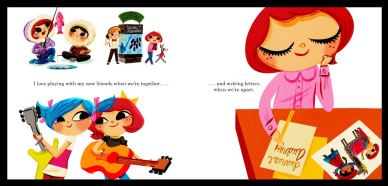
The illustrations are bright and cheery, giving Lily a sophisticated look. Young girls will like Lily and Lately Lily, though the book is more a travel log or a “This is my life,” than a story. Regardless, girls who love wearing Lately Lily will enjoy the picture book. Young girls new to Lately Lily will love the girl and her Zeborah. Many of them will want to transition into wearing Lately Lily clothes.
LATELY LILY: THE ADVENTURES OF A TRAVELLING GIRL. Text and illustrations copyright © 2014 by Micah Player. Reproduced by permission of the publisher, Chronicle Books, San Francisco, CA. .
Buy Lately Lily: The Adventures of a Travelling Girl at Amazon —B&N—Chronicle Books—your local bookstore.
—B&N—Chronicle Books—your local bookstore.
.
Learn more about Lately Lily HERE http://latelylily.com/
Meet the author/illustrator Micah Player, at his website: http://paperrifle.com/
Check out the Lately Lily store at the website: http://latelylily.com/shop/
Find other books at Chronicle Books’ website: http://www.chroniclebooks.com/
Also by Micah Player

The Around the World Puzzle
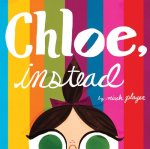
Chloe, Instead
. .
.
.
.
.
.
WIN Lately Lily: The Adventures of a Travelling Girl by LEAVING A COMMENT below this review. For additional entries, and MORE CHANCES TO WIN Lately Lily, and other wonderful children’s books, CLICK HERE TO WIN!
.

Filed under:
4stars,
Children's Books,
Contests-Giveaways,
Library Donated Books,
Picture Book Tagged:
adventures,
around-the-world,
Chronicle Books,
friendships,
Lately Lily,
London,
Micah Player,
Paris,
traveling,
travelling girl,
Zeborah 








By: JOANNA MARPLE,
on 5/9/2014
Blog:
Miss Marple's Musings
(
Login to Add to MyJacketFlap)
JacketFlap tags:
Uncategorized,
Paris,
Knopf,
Mary Grandpre,
Russia,
Munich,
abstract art,
Moscow,
Kandinsky,
teaching activities,
Perfect Picture Book Friday,
Barb Rosentock,
The Noisy Paint Box,
Add a tag
Title: The Colors and Sounds of Kandinsky’s Abstract Art -The Noisy Paint Box Written by Barb Rosenstock Illustrated by Mary Grandpré Published by Alfred A. Knopf, 2014 Ages: 5-11 Themes: abstract art, sounds, Kandinsky, historical fiction First lines: Vasya Kandinsky spent his days learning to … Continue reading →
Here is a sneak peek at the jacket cover of Carina Axelsson’s summer release, Model Undercover: Paris, a middle grade novel published by Sourcebooks Jabberwocky (July 1, 2014).
Periodically, and lately rather frequently, I get a hankering to go back to Paris. I spent a year in that incredible city, and have gone back a few time, but it always beckons me back. The city is my first love, it was a time of my youth and extreme freedom. It was the stuff of dreams.
I write about art, travel and romance. My novel A Hotel in Paris is set in the most romantic city in the world, and since summer and the travel season is almost upon us, I would like to offer a few tips to the city of light and romance that may be a bit off the beaten path.
By all means go to all must see places, and there are so many, but save some time for the other-must see places-go to the intimate and magnificent Rodin museum, it was his home, and his presence can still be felt in every piece exhibited, inside and in his gardens.
It is by far my most favorite museum that I have ever visited. His work is passionate, ardent, and profound. Every muscle strained, every sinew defined. Agony, joy, and in the case of the Balzac work, arrogance masterfully portrayed. Walk through the gardens, stop in the café in the garden and savor your brew in quiet contemplation.
Don’t neglect a stroll in the contemplative Luxembourg Gardens, find the Medici Fountain and the reflective pool, sit down on a bench and ponder…
For a taste of local wonder, lose yourself in the back streets of the left bank, start with Rue De La Huchette off Blvd St. Michel, pick a narrow cobble stoned street and start walking-do wear comfortable shoes. Aromas from many ethnic restaurants beckon you in, you can explore one narrow street after another.
For a romantic stroll do take the time to walk along the Seine, right alongside and back of Notre Dame, and the books stalls. Do so in the early morning, before the crowds and the stalls open, just when the city starts to wake, stop in a café and enjoy a respite. It is so quiet and peaceful and so incredibly romantic. It is equally enchanting late in the evening as the bookstalls start to close; a pervasive hush comes with dusk.
You will see a different Paris, an enchanting Paris; different from the hassle of the tour buses and the rush to get from one point to another without ever savoring the essence of the city. Take the time, and savor the city of lights. Don’t be afraid to get lost, carry a map with you. Paris is a walking city filled with treasures, and you will always find your way back to the next monument.
I had to share with you my favorite work of art at the Louvre-the Winged Victory.
Cheers,
Margot Justes
Blood Art
A Fire Within
A Hotel in Paris
A Hotel in Bath
Hot Crimes Cool Chicks
www.mjustes.com

By: JOANNA MARPLE,
on 4/16/2014
Blog:
Miss Marple's Musings
(
Login to Add to MyJacketFlap)
JacketFlap tags:
Flight School,
Interview,
penguins,
picture book,
picture books,
cats,
dogs,
Paris,
Illustrators,
Lita Judge,
parrots,
Illustrator interview,
paleontology,
Add a tag
This interview arose from one of those serendipitous moments. I had been liking all Lita’s posts on FB about her new picture book FLIGHT SCHOOL for several weeks and had been thinking that I must see if she would like … Continue reading →

By: Kirsty,
on 4/16/2014
Blog:
OUPblog
(
Login to Add to MyJacketFlap)
JacketFlap tags:
Humanities,
french literature,
Emile Zola,
*Featured,
zola,
rougon-macquart,
saccard,
bourse,
sigismond,
Literature,
money,
paris,
translation,
Finance,
OWC,
banking,
Oxford World's Classics,
Add a tag

By Valerie Minogue
Money is a tricky subject for a novel, as Zola in 1890 acknowledged: “It’s difficult to write a novel about money. It’s cold, icy, lacking in interest…” But his Rougon-Macquart novels, the “natural and social history” of a family in the Second Empire, were meant to cover every significant aspect of the age, from railways and coal-mines to the first department stores. Money and the Stock Exchange (the Paris Bourse) had to have a place in that picture, hence Money, the eighteenth of Zola’s twenty-novel cycle.
The subject is indeed challenging, but it makes an action-packed novel, with a huge cast, led by a smaller group of well-defined and contrasting characters, who inhabit a great variety of settings, from the busy, crowded streets of Paris to the inside of the Bourse, to a palatial bank, modest domestic interiors, houses of opulent splendour — and a horrific slum of filthy hovels that makes a telling comment on the social inequalities of the day.
Dominating the scene from the beginning is the central, brooding figure of Saccard. Born Aristide Rougon, Saccard already appears in earlier novels of the Rougon-Macquart, notably in The Kill, which relates how Saccard, profiting from the opportunities provided by Haussman’s reconstruction of Paris, made – and lost – a huge fortune in property deals. Money relates Saccard’s second rise and fall, but Saccard here is a more complex and riveting figure than in The Kill.

Émile Zola painted by Edouard Manet
It is Saccard who drives all the action, carrying us through the widely divergent social strata of a time that Zola termed “an era of folly and shame”, and into all levels of the financial world. We meet gamblers and jobbers, bankers, stockbrokers and their clerks; we get into the floor of the Bourse, where prices are shouted and exchanged at break-neck speed, deals are made and unmade, and investors suddenly enriched or impoverished. This is a world of insider-trading, of manipulation of share-prices and political chicanery, with directors lining their pockets with fat bonuses and walking off wealthy when the bank goes to the wall — scandals, alas, so familiar that it is hard to believe this book was written back in 1890! Saccard, with his enormous talent for inspiring confidence and manipulating people, would feel quite at home among the financial operators of today.
Saccard is surrounded by other vivid characters – the rapacious Busch, the sinister La Méchain, waiting vulture-like for disaster and profit, in what is, for the most part, a morally ugly world. Apart from the Jordan couple, and Hamelin and his sister Madame Caroline, precious few are on the side of the angels. But there are contrasts not only between, but also within, the characters. Nothing and no-one here is purely wicked, nor purely good. The terrible Busch is a devoted and loving carer of his brother Sigismond. Hamelin, whose wide-ranging schemes Saccard embraces and finances, combines brilliance as an engineer with a childlike piety. Madame Caroline, for all her robust good sense, falls in love with Saccard, seduced by his dynamic vitality and energy, and goes on loving him even when in his recklessness he has lost her esteem. Saccard himself, with all his lusts and vanity and greed, works devotedly for a charitable Foundation, delighting in the power to do good.
Money itself has many faces: it’s a living thing, glittering and tinkling with “the music of gold”, it’s a pernicious germ that ruins everything it touches, and it’s a magic wand, an instrument of progress, which, combined with science, will transform the world, opening new highways by rail and sea, and making deserts bloom. Money may be corrupting but is also productive, and Saccard, similarly – “is he a hero? is he a villain?” asks Madame Caroline; he does enormous damage, but also achieves much of real value.
Fundamental questions about money are posed in the encounter between Saccard and the philosopher Sigismond, a disciple of Karl Marx, whose Das Kapital had recently appeared — an encounter in which individualistic capitalism meets Marxist collectivism head to head. Both men are idealists in very different ways, Sigismond wanting to ban money altogether to reach a new world of equality and happiness for all, a world in which all will engage in manual labour (shades of the Cultural Revolution!), and be rewarded not with evil money but work-vouchers. Saccard, seeing money as the instrument of progress, recoils in horror. For him, without money, there is nothing.
If Zola vividly presents the corrupting power of money, he also shows its expansive force as an active agent of both creation and destruction, like an organic part of the stuff of life. And it is “life, just as it is” with so much bad and so much good in it, that the whole novel finally reaffirms.
Valerie Minogue has taught at the universities of Cardiff, Queen Mary University of London, and Swansea. She is co-founder of the journal Romance Studies and has been President of the Émile Zola Society, London, since 2005. She is the translator of the new Oxford World’s Classics edition of Money by Émile Zola.
For over 100 years Oxford World’s Classics has made available the broadest spectrum of literature from around the globe. Each affordable volume reflects Oxford’s commitment to scholarship, providing the most accurate text plus a wealth of other valuable features, including expert introductions by leading authorities, voluminous notes to clarify the text, up-to-date bibliographies for further study, and much more. You can follow Oxford World’s Classics on Twitter, Facebook, or here on the OUPblog.
Subscribe to the OUPblog via email or RSS.
Subscribe to only Oxford World’s Classics articles on the OUPblog via email or RSS.
Subscribe to only literature articles on the OUPblog via email or RSS.
Image credit: Émile Zola by Edouard Manet [public domain] via Wikimedia Commons.
The post Money matters appeared first on OUPblog.

Mini Labo have a fabulous new range of products since we last looked in with some being new arrivals for Spring Summer 2014. There are beautiful trays, tableware, cushions, zip up cases, and phone cases. I first became aware of Mini Labo through the Designers Guild shop in London and they have appeared in the Print & Pattern Books. The company was founded in 2004 by Caroline Diaz, Céline Héno
View Next 25 Posts
























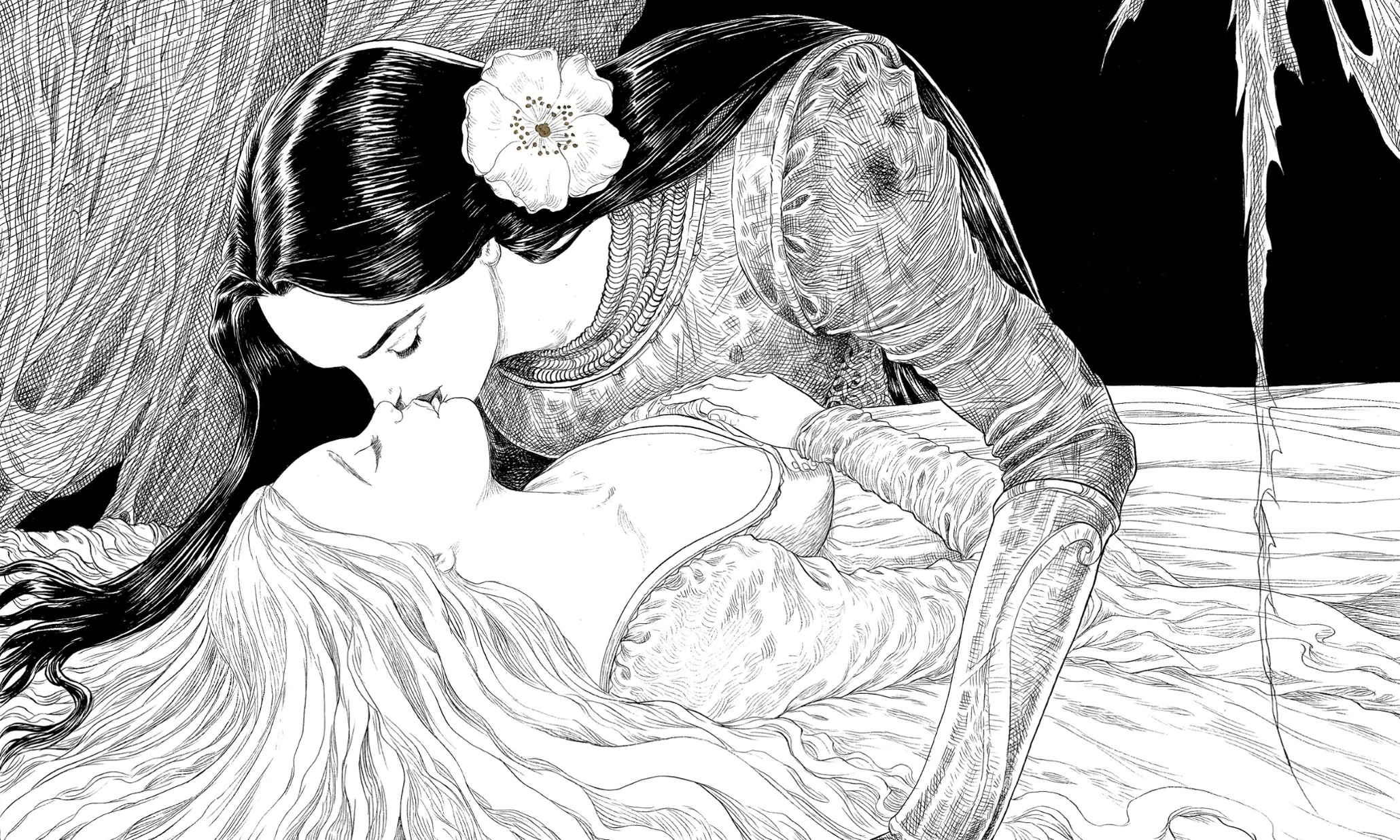
 .
.




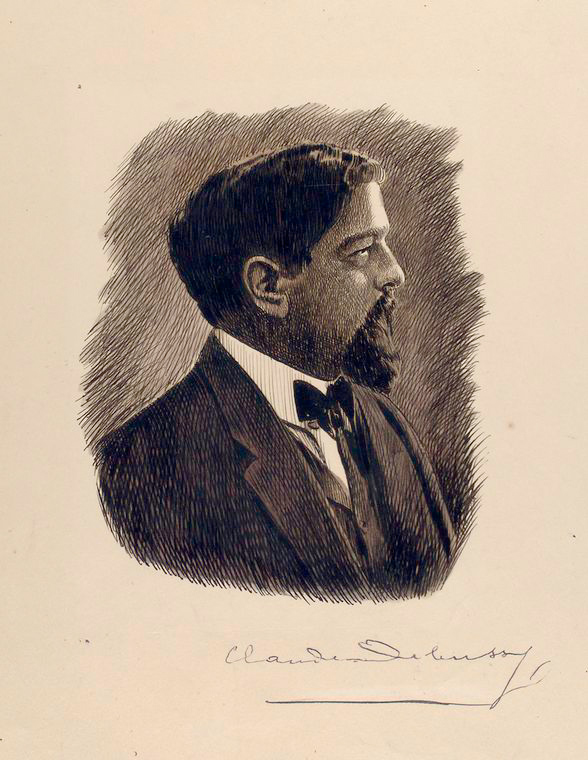







 “Every day is an adventure.”
“Every day is an adventure.”












The best family audiobook we’ve listened to is The Quigleys by Simon Mason. The kids love it. The grown ups love it. It doesn’t seem to be on audible anymore.
http://www.amazon.co.uk/Quigleys-Simon-Mason/dp/0754065863/ref=tmm_abk_swatch_0?_encoding=UTF8&sr=8-1&qid=1423726113
Thanks for the audiobook recommendation Penni, I’ll look into it.
coucou zoe !
I confirm your speculations are right !! Paris is of course not a white city at all but a mixed city with different people and different cultures and this is precisely what we enjoy in living in it…. I feel quite upset to see the diversity is missing but the dog poo is not !! isn’t it biased ? we do not have so much dog poo around ! fortunatly !!!
I love the doodle dress book ! Children always enjoy “cadavres exquis”, and if you add colours ! what could be better ?!
enjoy your holidays !
sophie.